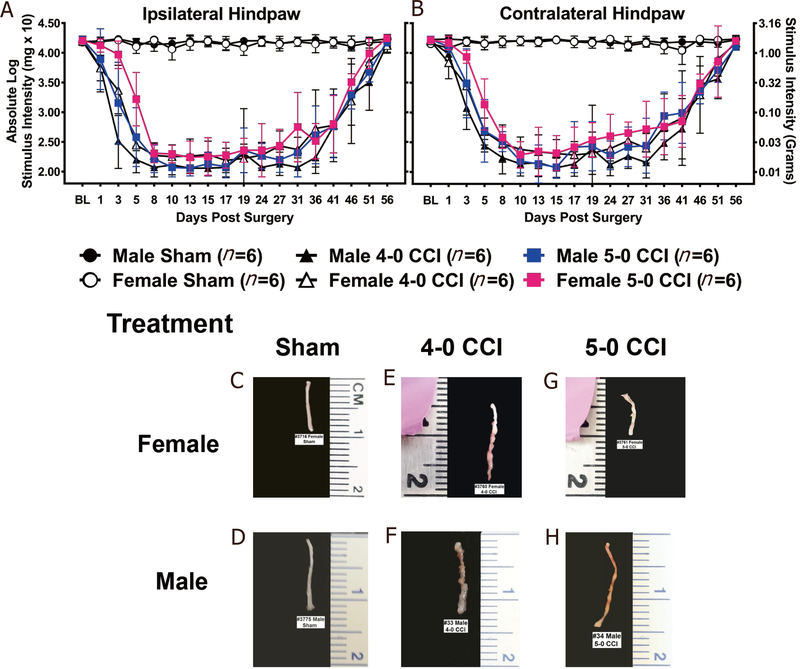Figure 1.
The timecourse of CCI-induced allodynia comparing 4–0 or 5–0 suture material is similar in both males and females. No significant differences were observed between groups at baseline (BL) assessment for hindpaw threshold responses either (A) ipsilateral or (B) contralateral to the sciatic nerve injury. Compared to mice that underwent sham manipulations, all mice with either 4–0 or 5–0 CCI reached maximal bilateral allodynia by Day 8–10 post-surgery and remained stably allodynic through Day 36 post-surgery. Main effects of time on hindpaw responses was observed from BL to Day 8 in the ipsilateral side (F2.4,74.7 = 207.56, P < 0.001) or Day 10 in the contralateral side (F2.7,81.5 = 212.64, P < 0.001). A main effect of surgery (ipsilateral: Day 8 – 27: F2,30 = 591.25, P < 0.001; contralateral: Day 10 – 19: F2,30 = 352.59, P < 0.001) was observed from hindpaw responses showing stable allodynia. A gradual spontaneous reversal of hindpaw responses similar to BL values was evident by Day 56 post-surgery, as supported by a main effect of time (ipsilateral: Day 27 – 56: F3.5,105.0 = 113.37, P < 0.001; contralateral: Day 19 – 56: F4.3,131.6 = 91.55, P < 0.001). Interestingly, sex and suture size had an effect on hindpaw responses only during the onset of allodynia, as shown by the main effect of sex (ipsilateral: BL - Day 8: F1,30 = 13.05, P = 0.001; contralateral: BL - Day 10: F1,30 = 9.03, P = 0.005). (C-H) Sciatic nerves were biopsied on Day 56 post-surgery. Compared to Sham (C) female and (D) male sciatic nerves, (E) female and (F) male nerves with peri-sciatic 4–0 CCI revealed a translucent sheath and remaining suture material surrounding the injury site, combined with significant discoloration and indentation of the nerves. (G) Female and (H) male mice with peri-sciatic 5–0 CCI revealed diminished or lack of sheath, and minimal suture material surrounding the injury site, combined with far less discoloration and indentation of the nerves. n = 6 for all groups

